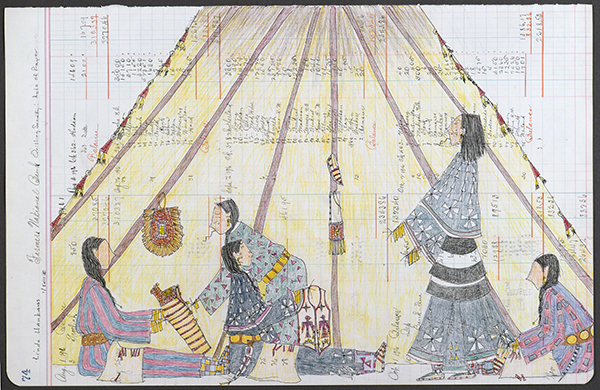Native American Heritage Month: Linda Haukaas
In Plains cultures, art forms associated with women (such as quilling and beadwork) and those associated with men (including ledger art) were, like gender roles, complementary. The art forms of both men and women were respected as ways of honoring and maintaining the dignity of the culture. In contemporary native arts, Linda Haukaas of Sicangu Lakota Sioux heritage has claimed the traditionally male art form of ledger art as a medium to document the lives of native women, rather than the traditional scenes of hunting and warrior activities of men.
 |
| Linda Haukaas (born 1957, Sicangu (Rosebud) Lakota Sioux Nation), Quilling Society: Acts of Prayer, 2010. Ink and colored pencil on historic ledger paper, 11 ½" x 17 ½" (29.2 x 44.5 cm). Courtesy of the Brooklyn Museum. © 2023 Linda Haukaas. (BMA-3141) |
In Quilling Society: Acts of Prayer, Haukaas highlights the importance of the quilling art form to native cultures. Quillwork, which decorated every conceivable type of utilitarian object, was an art form specifically performed by women. Haukaas’s composition includes traditional profile representations of figures, while establishing a space within the contours of a tipi. Setting was traditionally ignored in ledger drawings, where space was established vertically. Haukaas’s painting displays many of the everyday objects that were ornamented with quilling such as vests, moccasins, saddle bags, and child carriers. The artist has made a point of having the subject completely dominate the surface, while still allowing notations on a Farmers National Bank spreadsheet to remain visible. The repurposing of found paper is a reference to the history of ledger art.
The daughter of a Sicangu Lakota father and Puerto Rican mother, Haukaas was born on the Rosebud Lakota Sioux Reservation in Okreek, South Dakota. She grew up spending time in both San Juan, Puerto Rico, and the Okreek Reservation. On the reservation, she learned to hunt, shoot, fish, ride bareback, quilt, bead, and dance. The differences in the two cultures influenced her world view, as well as the subject matter of her art. She earned a BA from the University of Nebraska, Lincoln, in 1978 and a Masters in Community Planning from the same school in 1987. In 2007. Haukaas earned a BFA from the University of Southern Florida.
Haukaas was artistic from childhood, participating in drawing, dollmaking, beadwork, and creating pictures on clothing. During the Feminist Art Movement of the 1970s, when gender roles began to become more fluid, she started to explore ledger art. Expressing her memories of female activities, family, and general Lakota life, Haukaas broke boundaries in adapting traditionally male ledger art. Her works assert women’s roles in indigenous society, their strength, and their contributions.
The Sioux nation was originally made up of seven bands, or “council fires”: four Dakota, two Nakota, and one Lakota. This group of council fires was called the Oceti Sakowin. The nearby Chippewa called it the Nadow-is-iw, which the French corrupted into the term Nadowessioux. That, in turn, was shortened to Sioux. The Dakota had their first contact with Europeans (French trappers) near Green Bay, Wisconsin, in 1640 and 1658.
In 1680, the Lakota (or Tiyospaye, meaning “extended family”) were living farther west on the upper Mississippi and in central Minnesota. By 1794, after numerous wars with the Chippewa, Arikara, Kiowa, and Crow bands, the Sioux nation controlled the Black Hills. In the 1830s and 1840s, increased European American migration westward caused conflict with Native bands. Repeated violations of the treaties of 1851 and 1868 led to war with the United States government in 1870, which culminated in the Battle of Little Big Horn in 1876.
Although indigenous Plains cultures had no written language to record their history, they did have a long tradition of preserving oral histories pictorially. For centuries, Plains Indian men kept visual historical records, first as petroglyphs and pictographs on rock faces and then as painted scenes on animal hide, canvas, and muslin. Historical records, as well as individual visions and experiences, were painted on tipis (both interior and exterior) and on hide garments.
After the 1870s, the Lakota Sioux continued to document their way of life. Ledger painting of the post-conquest period is by far the most renowned genre. Since contact with Europeans, they had access to previously unknown art materials such as inks, pencils, watercolors, and crayons. The paper native artists adapted as their “canvas” came from ledgers white people used to keep inventories. Ledger paintings were done in media obtained through trade or scavenging on battlefields. Over the last forty years, native ledger art has been revived, predominantly by women artists.
Correlations to Davis Programs: Explorations in Art 2E Grade 1: 5.4; Explorations in Art 2E Grade 2: 5.6; Explorations in Art 2E Grade 5: 1.7., 1.8, 1.9; Experience Art: 2.1; A Community Connection 2E: 2.1; A Personal Journey 2E: 1.4, 2.3, 2.4; A Global Pursuit 2E: 2.5, 5.1; Discovering Art History 4E: 4.10


Comments